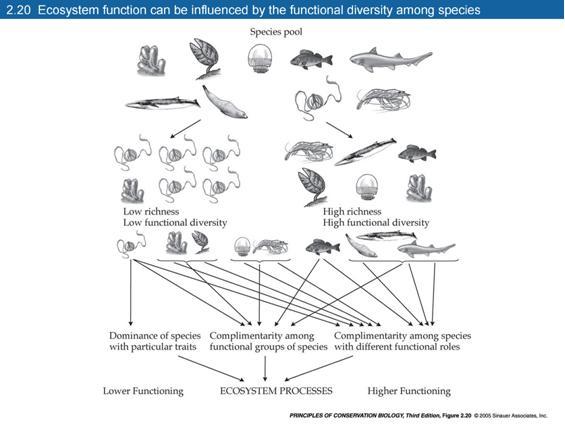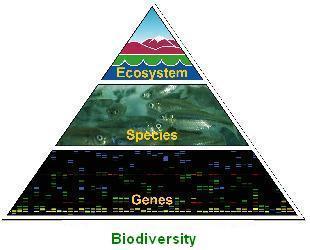Difference between revisions of "Marine Biodiversity"
Dronkers J (talk | contribs) |
Dronkers J (talk | contribs) |
||
| (One intermediate revision by the same user not shown) | |||
| Line 29: | Line 29: | ||
<ref name="Steele">Steele, J.H. et al. (Ed.) (2001), Encyclopedia of ocean sciences. Academic Press: San Diego, p756 vol. 2 D-H </ref>Marine organisms contribute to many critical processes that have direct and indirect effects on the health of the oceans and humans. What is obvious is that there are specific species and functional groups that play critical roles in important ecosystem processes, and the loss of these species may have significant influences on the whole ecosystem. | <ref name="Steele">Steele, J.H. et al. (Ed.) (2001), Encyclopedia of ocean sciences. Academic Press: San Diego, p756 vol. 2 D-H </ref>Marine organisms contribute to many critical processes that have direct and indirect effects on the health of the oceans and humans. What is obvious is that there are specific species and functional groups that play critical roles in important ecosystem processes, and the loss of these species may have significant influences on the whole ecosystem. | ||
| − | <ref name="Steele">Steele, J.H. et al. (Ed.) (2001), Encyclopedia of ocean sciences. Academic Press: San Diego, p756 vol. 2 D-H </ref>Primary and [[secondary production]] are important mechanisms by which marine communities contribute to global processes. It has been estimated that half the [[primary production]] on earth is attributable to marine species. Without primary producers in surface waters, the oceans would quickly run out of food, but without planktonic and benthic organisms to facilitate [[ | + | <ref name="Steele">Steele, J.H. et al. (Ed.) (2001), Encyclopedia of ocean sciences. Academic Press: San Diego, p756 vol. 2 D-H </ref>Primary and [[secondary production]] are important mechanisms by which marine communities contribute to global processes. It has been estimated that half the [[primary production]] on earth is attributable to marine species. Without primary producers in surface waters, the oceans would quickly run out of food, but without planktonic and benthic organisms to facilitate [[Nutrient conversion in the marine environment|nutrient cycling]], the primary producers would quickly become nutrient limited. |
<ref name="Marbef">http://www.marbef.org </ref>The marine ecosystem provide us a lot of goods and services like food provision, nutrient cycling, gas and climate regulation, … .Looking at ecosystems in terms of the goods and services they provide, allows us to realize their full value and our dependency on those systems in the broadest sense. | <ref name="Marbef">http://www.marbef.org </ref>The marine ecosystem provide us a lot of goods and services like food provision, nutrient cycling, gas and climate regulation, … .Looking at ecosystems in terms of the goods and services they provide, allows us to realize their full value and our dependency on those systems in the broadest sense. | ||
| Line 51: | Line 51: | ||
|AuthorName=Charlotte}} | |AuthorName=Charlotte}} | ||
| − | [[Category: | + | [[Category: MarBEF Wiki]] |
[[Category:Marine Biodiversity]] | [[Category:Marine Biodiversity]] | ||
Latest revision as of 10:40, 4 February 2021
This article provides a summary of the components that make up diversity in the marine environment. It is a 'jumping off point' for more detailed information on the organisms living in the sea as well as the values accruing to them and the ecosystem in which they live.
Contents
What is marine biodiversity?
[1]Biodiversity is an all-inclusive term to describe the total variation among living organisms of our planet. In its simplest form, biodiversity or biological diversity is therefore 'Life on Earth' and includes marine biodiversity 'Life in the Seas and Oceans.` The marine environment has a very high biodiversity because 32 out of the 33 described animal phyla are represented in there.
[2]Biodiversity includes four main components:
- Genetic diversity refers to the genetic variation that occurs among members of the same species.
- Species diversity (taxonomic diversity) refers to the variety of species or other taxonomic groups in an ecosystem.
- Ecosystem diversity refers to the variety of biological communities found on earth. With ecosystem diversity we generally consider its two levels, that is, communities and ecosystems.
- Functional diversity refers to the variety of biological processes, functions or characteristics of a particular ecosystem.
Genetic, species and ecosystem diversity are also often grouped as ‘structural diversity’. An example of species diversity is the number of all fish species in the North Sea; genetic diversity indicates for instance the differences in genes between different populations of the same fish species and ecosystem diversity is for instance the number of communities living in different habitats/ecosystems (rocky shores, sandy beaches, soft subtidal, …).
An example of functional diversity is the number of filter feeders in an ecosystem compared to the number of grazers. Functional diversity is thought to be one of the main factors determining the long-term stability of an ecosystem and its ability to recover from major disturbances.

Biodiversity encompasses many levels of organization including genes, species, habitats, communities and ecosystems. Although species diversity is the most commonly used measure of taxonomic diversity (or diversity between types of organisms), other measures of taxonomic diversity exist, the most common of which is phyletic diversity. Phyletic diversity is the variation in the working body plans (phyla) of organisms. An example of a phylum is the Arthropoda, which includes organisms such as crabs, lobsters, shrimp as marine animals and insects and spiders as terrestrial organisms.
Why is marine biodiversity important?
[4]Marine organisms contribute to many critical processes that have direct and indirect effects on the health of the oceans and humans. What is obvious is that there are specific species and functional groups that play critical roles in important ecosystem processes, and the loss of these species may have significant influences on the whole ecosystem.
[4]Primary and secondary production are important mechanisms by which marine communities contribute to global processes. It has been estimated that half the primary production on earth is attributable to marine species. Without primary producers in surface waters, the oceans would quickly run out of food, but without planktonic and benthic organisms to facilitate nutrient cycling, the primary producers would quickly become nutrient limited.
[1]The marine ecosystem provide us a lot of goods and services like food provision, nutrient cycling, gas and climate regulation, … .Looking at ecosystems in terms of the goods and services they provide, allows us to realize their full value and our dependency on those systems in the broadest sense.
Related articles
- Measurements of biodiversity
- Ecosystem diversity
- Functional diversity in marine ecosystems
- Genetic diversity
- Species diversity
References
- ↑ 1.0 1.1 http://www.marbef.org Cite error: Invalid
<ref>tag; name "Marbef" defined multiple times with different content - ↑ Thorne-Miller Boyce(1999), The living ocean: understanding and protecting marine biodiversity. United States of America. 213p
- ↑ Groom, M.J., Meffe, G.K., Carroll, C.R. and contributors, 2005. Principles of Conservation Biology, Third Edition, Sinauer Associates.
- ↑ 4.0 4.1 Steele, J.H. et al. (Ed.) (2001), Encyclopedia of ocean sciences. Academic Press: San Diego, p756 vol. 2 D-H
Please note that others may also have edited the contents of this article.
|
